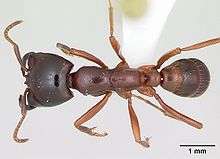Dorylinae
Dorylinae is an ant subfamily, with distributions in both the Old World and New World. In 2014, Brady et al. synonymized the previous dorylomorph subfamilies (Aenictinae, Aenictogitoninae, Cerapachyinae, Ecitoninae, and Leptanilloidinae) under the Dorylinae.[2]
| Dorylinae | |
|---|---|
 | |
| D. gribodoi | |
| Scientific classification | |
| Kingdom: | Animalia |
| Phylum: | Arthropoda |
| Class: | Insecta |
| Order: | Hymenoptera |
| Family: | Formicidae |
| Subfamily: | Dorylinae Leach, 1815 |
| Type genus | |
| Dorylus Fabricius, 1793 | |
| Diversity[1] | |
| 28 genera | |
Genera
- Acanthostichus Mayr, 1887
- Aenictogiton Emery, 1901
- Aenictus Shuckard, 1840
- Cerapachys Smith, 1857
- Cheliomyrmex Mayr, 1870
- Chrysapace Crawley, 1924
- Cylindromyrmex Mayr, 1870
- Dorylus Fabricius, 1793
- Eburopone Borowiec, 2016
- Eciton Latreille, 1804
- Eusphinctus Emery, 1893
- Labidus Jurine, 1807
- Leptanilloides Mann, 1923
- Lioponera Mayr, 1879
- Lividopone Bolton & Fisher, 2016
- Neivamyrmex Borgmeier, 1940
- Neocerapachys Borowiec, 2016
- Nomamyrmex Borgmeier, 1936
- Ooceraea Roger, 1862
- Parasyscia Emery, 1882
- †Procerapachys Wheeler, 1915
- Simopone Forel, 1891
- Sphinctomyrmex Mayr, 1866
- Syscia Roger, 1861
- Tanipone Bolton & Fisher, 2012
- Vicinopone Bolton & Fisher, 2012
- Yunodorylus Xu, 2000
- Zasphinctus Wheeler, 1918
gollark: Although said nomads would probably just die off before the sun consumes earth.
gollark: This is probably not sustainable (someone is likely to invent technology again), worse, and either comes under "never using nonrenewable resources" or "will run out eventually".
gollark: It's an example. There are other small-scale manufacturing things.
gollark: Apart from the minor cascading bee events, no.
gollark: > <meta charset="ISO-8859-1">This is wrong and will actually break with some of the round 3 entries.
References
- Bolton, B. (2016). "Dorylinae". AntCat. Retrieved 19 October 2016.
- Brady, Seán G; Fisher, Brian L; Schultz, Ted R; Ward, Philip S (2014). "The rise of army ants and their relatives: diversification of specialized predatory doryline ants". BMC Evolutionary Biology. 14: 2–14. doi:10.1186/1471-2148-14-93. PMC 4021219. PMID 24886136.
This article is issued from Wikipedia. The text is licensed under Creative Commons - Attribution - Sharealike. Additional terms may apply for the media files.